Demolition Contractors Silver Lake
Best Demolition Contractors Near Me in Silver Lake
Receive up to 3 Demolition Contractors Near Me quotes for your project today! Compare profiles, reviews, accreditations, portfolio, etc... and choose the best service.

Excavating Materials & Equipment, Inc.
37 reviews849 Route 539, New Egypt, 08533, USExcavating Materials & Equipment, Inc. (EME) For over three decades, EME has been a leading supplier of sand, stone, gravel, topsoil, and DOT I range products for the construction industry in central New Jersey. We operate two sand and gravel mines, ensuring we can efficiently produce and deliver materials within the tri-state area using our fleet of tri-axle dump trucks and heavy equipment. Our commitment to quality extends beyond material supply. The Plumsted facility is permitted to accept soils and dredge soils for disposal and reuse, adhering to strict DEP and Army Corp of Engineers specifications. Our pugmill blending plant and screening equipment allow us to create customized materials tailored to your specific project requirements.
- Services
- Why Us?
- Gallery
Get Quote
Dirt Dynasty LLC
54 reviewsBridgewater, New Jersey, USWelcome to Dirt Dynasty, where our foundation is built on the very grounds we work with. Established in recent years by a team of ambitious professionals, we've quickly risen through the ranks to carve our niche in the excavation and masonry service industry. Our journey began when our founders, armed with years of invaluable experience and a vision of independence, decided it was time to stop working under others and instead, build their own legacy. Thus, Dirt Dynasty was born. At Dirt Dynasty, we specialize in a wide array of services designed to meet the diverse needs of both businesses and homeowners alike. Our expertise spans trenching, creating your dream pools and ponds, installing septic tanks, oil tank removals, and the careful demolition of structures. But our craftsmanship doesn’t end there; we also excel in constructing durable retaining walls, crafting picturesque outdoor patios, and setting up functional outdoor kitchens that become the heart of your backyard gatherings. Understanding the needs of our clients extends beyond just the services we offer. We also provide material deliveries including clean stone, fill, mulch, pond rocks, and more, ensuring that your projects have the high-quality materials they require, delivered right to your doorstep. What sets Dirt Dynasty apart is not just our comprehensive service offerings, but our unwavering commitment to satisfaction. We believe in building relationships that go beyond the transaction. Every project we undertake is a testament to our dedication to excellence, attention to detail, and the respect we hold for your vision and space. We strive to not only meet your expectations but exceed them, ensuring that every interaction with us is as seamless and positive as possible. Even if you don’t have an immediate need for our services, we invite you to reach out. Let's lay the groundwork for a future project, discuss your ideas, or simply get to know each other better. At Dirt Dynasty, we believe in fostering connections that might not bear immediate fruit but will grow into strong, supportive relationships over time. Thank you for considering Dirt Dynasty for your excavation and masonry needs. We look forward to the opportunity to work with you and to add your project to the legacy of our dynasty.
- Services
- Why Us?
- Gallery
Get Quote
Mississippi 811, Inc.
4.823 reviews200 Country Pl Pkwy, Pearl, 39208, USAbout MS811 MS811 is a vital resource for anyone planning to dig in Mississippi. Our mission is to protect underground infrastructure and ensure the safety of excavators, homeowners, and the public. We provide a free, easy-to-use service that helps you locate underground utilities before you dig. By calling 811 or visiting our website, you can request a locate request and ensure that you are digging safely. We are committed to providing our customers with the highest level of service and support. Our team of experts is available 24/7 to answer your questions and help you navigate the process of digging safely. We also offer a variety of resources and information to help you understand the importance of damage prevention and the laws and regulations that govern excavation in Mississippi. We believe that everyone has a role to play in protecting underground infrastructure. By working together, we can prevent damage to utilities and ensure the safety of our communities.
- Services
- Why Us?
- Gallery
Get Quote
Bencardino Excavating Inc
54 reviews1423 Wells Drive, Bensalem, 19020, USGet the job done right with Bencardino Excavating! See How Bencardino Excavating Projects Are Setting The Standard... A long track record of successful projects, larger footprint excavating and sitework capabilities, competitive pricing, a commitment to working safely, and quality workmanship. When you hire Bencardino Excavating with our ability to handle all aspects of your sitework, and possessing decades of experience, you will keep your project on schedule and eliminate delays and change orders that are common when hiring multiple contractors for your project. An Excavating And Sitework Contractor You Can Count On... Bencardino Excavating has over thirty years of experience providing diversified, highly dependable excavating and sitework contracting for our clients in Philadelphia, and the Delaware Valley. As an excavating and sitework contractor, our capabilities allow us to handle all aspects of your project, large or small in a safe, professional, and organized way. Bencardino Excavating has a fleet of heavy-construction equipment, a team of over 140 professionals and the experience to see through any sitework project from start to finish. Our team will bring your project in on time and within budget. Bencardino’s capabilities include: demolition, clearing, excavation, grading, underground utility installation for fire, storm, water and sewer, concrete, paving and emergency services.
- Services
- Why Us?
- Gallery
Get Quote
Blackwater Draw Locality 1
4.556 reviews1500 S. Ave K, Lea Hall Room 163, Portales, 88130, USThe Blackwater Draw Museum seeks to foster preservation and education of the heritage of New Mexico, the Southern High Plains, and the greater Southwest through exhibitions, educational programs, collections, and research, while enriching and supporting the educational goals and mission of ENMU. The Blackwater Draw Museum is a small museum located on the campus of Eastern New Mexico University in Portales, New Mexico. The museum is home to a collection of artifacts from the Blackwater Draw National Historic Landmark, a site that has been inhabited by humans for over 13,500 years. The museum offers a variety of exhibits, educational programs, and research opportunities. Visitors can learn about the history of the Blackwater Draw site, the cultures that have lived there, and the archaeology of the region. The museum also has a collection of artifacts from the Casas Grandes culture, a prehistoric culture that flourished in the Southwest from about 1300 to 1450 AD. The museum is open to the public and offers a variety of tours and programs. The museum is a great place to learn about the history and culture of the Southwest. The Blackwater Draw Museum is a great place to learn about the history and culture of the Southwest. The museum offers a variety of exhibits, educational programs, and research opportunities. Visitors can learn about the history of the Blackwater Draw site, the cultures that have lived there, and the archaeology of the region. The museum also has a collection of artifacts from the Casas Grandes culture, a prehistoric culture that flourished in the Southwest from about 1300 to 1450 AD. The museum is open to the public and offers a variety of tours and programs.
- Services
- Why Us?
- Gallery
Get Quote
Roy Anderson Corp
4.128 reviews11400 Reichold Road, Gulfport, 39503, USAbout Roy Anderson Corp Roy Anderson Corp is an innovative construction company with unique strengths, committed to delivering unsurpassed customer service and performance to customers, creating exciting opportunities for associates and bound together by shared core beliefs of safety, quality and integrity. Since 1955 Roy Anderson Corp has delivered exceptional construction services including Preconstruction, Design-Build, General Contracting and Construction Management. We are a wholly owned subsidiary of Tutor Perini Corporation (NYSE: TPC) who is consistently ranked among the top builders in the United States by Engineering News Record.
- Services
- Why Us?
- Gallery
Get Quote
Del Casale Excavating
511 reviews1000 County Route 106, Clifton Park, 12180, USDel Casale Excavating: Your Trusted Partner for Excavation Services Del Casale Excavating is a family-owned and operated business with over 20 years of experience in the excavation industry. We are committed to providing our clients with high-quality, reliable, and affordable services. Our team of experienced professionals is dedicated to exceeding your expectations and delivering exceptional results. We understand that every project is unique, and we take the time to listen to your needs and develop a customized plan that meets your specific requirements. Whether you need site preparation, foundation excavation, utility installation, or any other excavation service, we have the expertise and equipment to handle the job efficiently and effectively. At Del Casale Excavating, we are committed to safety and environmental responsibility. We use the latest technology and equipment to minimize our impact on the environment and ensure the safety of our workers and the public. Contact us today for a free consultation and let us help you bring your project to life.
- Services
- Why Us?
Get Quote
K & A Excavating Co Inc.
4.522 reviews2204 US Highway 130 N, Dayton, 08852, USAbout K & A Excavating Co. Inc K & A Excavating Co. Inc is a family-owned business based in Dayton, New Jersey. We are a reputable excavation contractor that values superior workmanship, attention to detail, and prompt services. With decades of experience and a wide array of heavy-duty equipment available to use, our professional company can get your job done in no time at all! At K & A Excavating Co. Inc, we have built our reputation on our commitment to providing quality service, which has earned us many valuable customers. With more than 30 years of experience, we are the go-to company for customers when they're in need of asphalt removal, land clearing, or site preparation. Our company uses only the best equipment for each job. In addition, we maintain a skilled staff to perform all projects. They are more than happy to answer any of your questions regarding our services. K & A Excavating Co. Inc's mission is to provide customers with courteous and friendly service and quality workmanship. Request a free estimate from us today for your project!
- Services
- Why Us?
- Gallery
Get Quote
The New Mexico Office of Archaeological Studies
4.312 reviews7 Old Cochiti Road, Santa Fe, 87507, USAbout the Office of Archaeological Studies The New Mexico Office of Archaeological Studies (OAS) conducts archaeological research projects throughout New Mexico with a diverse group of 13 archaeologists and support staff. Our mission is to identify, interpret, and share information about prehistoric and historic sites across the state. OAS serves other State agencies and private organizations that require archaeological studies as part of their development projects. In addition, we provide ethnographic and historical research services and have an education outreach program that directly interacts with New Mexicans in order to answer their questions about archaeology, history, and the heritage of New Mexico. That program twice received the Society for American Archaeology’s Excellence in Public Education Award, in 2005 and again in 2012. In addition to client-initiated projects, OAS conducts research projects that are funded by grants and private donations. Many of the projects make use of a dedicated corps of volunteers or involve our many research associates. OAS provides training opportunities for university students and makes use of their skills in the latest technology. We also engage in educational outreach programs in surrounding states. OAS has five specialized laboratories, a research library, and a publications department. Our archaeomagnetic dating laboratory is one of two full-time laboratories in the United States that are dedicated to this dating technique and our low-energy plasma radiocarbon sampling laboratory enables us to nearly non-destructive date fragile archaeological materials. Departmental Overview The New Mexico Office of Archaeological Studies has been providing cultural resource management services throughout New Mexico since 1952. OAS continues to fulfill the Museum of New Mexico’s commitment to the highway archaeology program and has expanded to include a diverse client base. Our list of clients spans the breadth of private and public customers, yet much of the work that we have completed is for return clients. Since 1952 OAS archaeologists have conducted over 800 archaeological projects and produced nearly 1,000 reports. We have worked throughout New Mexico, adjacent states, and northern Mexico, with reports available on projects in all areas.
- Services
- Why Us?
- Gallery
Get Quote
Patriot Excavating LLC
Woodbridge, USMeeting Your Excavation Needs Since 1999... Patriot Excavating has been providing Central NJ with exceptional customer service while meeting your excavation needs. As an excavating contractor, Patriot Excavating is here to help you with your next project, specializing in site work, underground utilities, digging basements, septic systems, and much more. Call us at 732-938-3470 to schedule a site visit and FREE estimate. Why Choose Us Experience With over 40 years of experience, you can expect the job to be done right and in a timely fashion. Integrity Patriot Excavating takes pride in being honest and forthright with its customers. Ethical As a Christian owned company, you can count on professionalism, transparency, and quality to be top priorities.
- Services
- Why Us?
- Gallery
Get Quote
Over 22,076+ Excavation Contractors registered
Our excavation contractors operate in Silver Lake & beyond!
ExcavationHQ has curated and vetted the Best Excavation Businesses arround Silver Lake. Find the most trustworthy contractor today.
Frequently Asked Questions About Demolition Contractors
- Feasibility Studies: Assessing the viability and challenges of a demolition project.
- Demolition Planning: Developing demolition plans, including method selection, sequencing, and safety procedures.
- Permitting Assistance: Navigating the demolition permitting process and ensuring compliance with regulations.
- Hazardous Material Surveys: Identifying and managing hazardous materials, such as asbestos and lead paint.
- Cost Estimating: Providing accurate cost estimates for demolition services.
- Project Management: Overseeing the demolition process and ensuring it proceeds as planned.
- Experience: Look for companies with a proven track record and years of experience in the demolition industry.
- Licensing and Insurance: Ensure the contractor is properly licensed to operate in your area and carries adequate insurance to protect you from liability.
- Safety Record: Inquire about their safety protocols and accident history. A reputable contractor prioritizes safety.
- References and Reviews: Ask for references from past clients and check online reviews to gauge their reputation and customer satisfaction.
- Professionalism: Choose a company that communicates clearly, provides detailed estimates, and has a courteous and responsive team.
What is the role of a demolition consultant?
How do I find a reputable demolition contractor?
Do I need a permit for demolition?
What is a demolition bond?
What is the role of a demolition consultant?
- Feasibility Studies: Assessing the viability and challenges of a demolition project.
- Demolition Planning: Developing demolition plans, including method selection, sequencing, and safety procedures.
- Permitting Assistance: Navigating the demolition permitting process and ensuring compliance with regulations.
- Hazardous Material Surveys: Identifying and managing hazardous materials, such as asbestos and lead paint.
- Cost Estimating: Providing accurate cost estimates for demolition services.
- Project Management: Overseeing the demolition process and ensuring it proceeds as planned.
How do I find a reputable demolition contractor?
- Experience: Look for companies with a proven track record and years of experience in the demolition industry.
- Licensing and Insurance: Ensure the contractor is properly licensed to operate in your area and carries adequate insurance to protect you from liability.
- Safety Record: Inquire about their safety protocols and accident history. A reputable contractor prioritizes safety.
- References and Reviews: Ask for references from past clients and check online reviews to gauge their reputation and customer satisfaction.
- Professionalism: Choose a company that communicates clearly, provides detailed estimates, and has a courteous and responsive team.